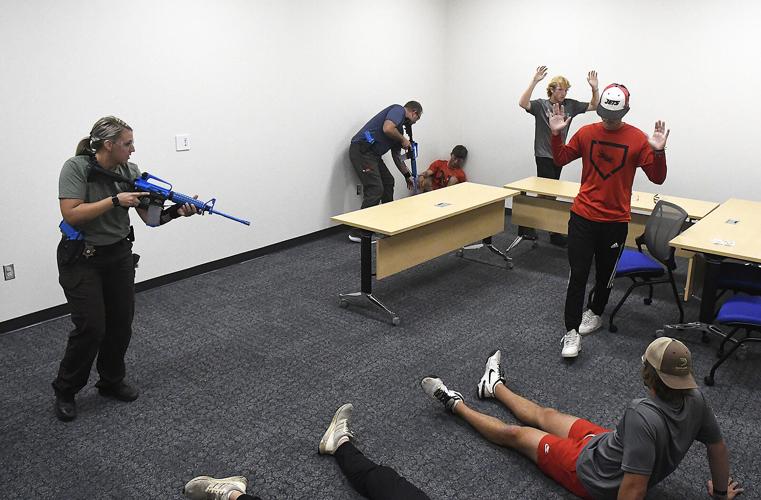The Relevance of Active Shooter Training in High-Risk Settings
The Relevance of Active Shooter Training in High-Risk Settings
Blog Article
Implementing Active Shooter Training: Best Practices for Producing a Safe and Prepared Neighborhood Setting
As areas confront the unsettling reality of active shooter occurrences, the application of thorough training programs comes to be critical. What are the vital components that can transform a standard training program right into a robust model for neighborhood resilience?

Recognizing the Requirement for Educating
In an age marked by boosting cases of violence in public spaces, comprehending the need for active shooter training has actually never ever been more crucial. The frequency of mass shootings throughout numerous environmentsâEUR" such as institutions, offices, and shopping centersâEUR" highlights the seriousness for individuals and companies to be planned for such emergency situations. Active shooter situations can unravel rapidly, leaving little time for people to respond properly. Comprehensive training initiatives can furnish participants with the understanding and abilities to react decisively.
Additionally, the psychological effect of physical violence on people and areas can not be overemphasized. Training promotes a feeling of empowerment and readiness, making it possible for individuals to really feel even more safe in their environments. It additionally promotes a culture of security, where understanding and caution come to be integral components of day-to-day live. The benefits of energetic shooter training expand past immediate feedback; they include boosting interaction methods and boosting general precaution within organizations.
Key Elements of Effective Programs
Effective energetic shooter training programs include a number of essential elements that boost readiness and feedback capacities. Extensive educational program advancement is essential, making certain that training material is pertinent, evidence-based, and tailored to the details needs of the company or community. This consists of comprehending the dynamics of energetic shooter events and the emotional influence on people entailed.
Second, practical training situations need to be utilized to replicate potential circumstances, permitting participants to exercise decision-making and response strategies in a controlled environment. These drills assist in muscle memory and develop confidence among individuals.
Third, a focus on interaction methods is vital. Establishing clear lines of interaction amongst police, emergency situation -responders, and individuals makes certain collaborated feedbacks during an occurrence. Routine updates and refresher course courses help maintain communication pathways clear and reliable.
4th, ongoing assessment and comments systems should be integrated right into the training program - active shooter training. Assessing the performance of training with individual responses and efficiency metrics permits for constant enhancement
Last but not least, cultivating a society of safety and security and readiness within the neighborhood encourages alertness and proactive measures, ensuring that individuals are not just experienced but also participated in preserving a safe and secure atmosphere.
Engaging Area Stakeholders

To efficiently involve these stakeholders, it is necessary to communicate the goals and advantages of the training. Holding informative sessions can assist clarify the training's function, address problems, and describe the functions each stakeholder may play. Furthermore, producing a stakeholder consultatory committee can help with continuous discussion, enabling varied viewpoints and understandings to be incorporated right into the training program.
Building connections with area leaders and organizations is also crucial. Their support can enhance outreach efforts, rise participation, and make certain that training is customized to the unique demands of the neighborhood. Additionally, stakeholders can aid in distributing details and sources, reinforcing the message of security and readiness.
Inevitably, engaging neighborhood stakeholders not only reinforces the training effort but also grows a sense of possession amongst locals, bring about an extra durable and educated area efficient in responding properly to potential dangers.
Educating Distribution Approaches
Using a range of training delivery techniques is necessary to fit the varied discovering styles and needs of individuals in energetic shooter training programs (active shooter training). Efficient training can take numerous forms, consisting of talks, hands-on simulations, on the internet components, and interactive workshops. Each technique offers a distinct objective and can boost the overall knowing experience

Online components offer adaptability and availability, enabling participants to find out at their own rate. These can include videos, quizzes, and conversations to gauge understanding. Interactive workshops motivate team discussions and problem-solving, advertising teamwork and communication abilities.
Incorporating a mixed technique that incorporates these methods not just improves the training experience but likewise makes certain that individuals are better prepared to respond effectively in case of an energetic shooter situation (active shooter training). By addressing different finding out choices, companies can develop an extra informed and responsive community
Continuous Assessment and Renovation
Normal analysis and improvement of energetic shooter training programs are crucial to maintaining their relevance and effectiveness. As risks develop, so need to the methods and techniques used in training. Continual examination makes certain that training web content mirrors the most recent knowledge on energetic shooter cases, including lessons found out from recent occasions and readjusting for arising patterns.
To promote this process, organizations should develop responses systems that include participant evaluations, expert testimonials, and occurrence debriefs. Gathering data on individual efficiency during drills and exercises is essential, as it highlights locations requiring enhancement and informs future training sessions. Additionally, involving with regulation enforcement and emergency -responders can give beneficial insights into the usefulness and applicability of training methods.
Consistently set up testimonials of training materials and techniques need to be mandated, cultivating a setting of technology and flexibility. Organizations needs to likewise motivate a society of ongoing understanding, where personnel participants really feel equipped to recommend modifications based on their experiences. By Look At This dedicating to continual assessment and enhancement, organizations not just boost the efficiency of their active shooter training programs yet likewise strengthen their total commitment to safety and security and preparedness within the area.
Verdict
In final thought, efficient execution of active shooter training requires a thorough approach that prioritizes neighborhood interaction and practical simulations. Ultimately, a commitment to continuous training and improvement grows a culture of watchfulness and preparedness, making certain a more secure check environment for all neighborhood participants.
Report this page